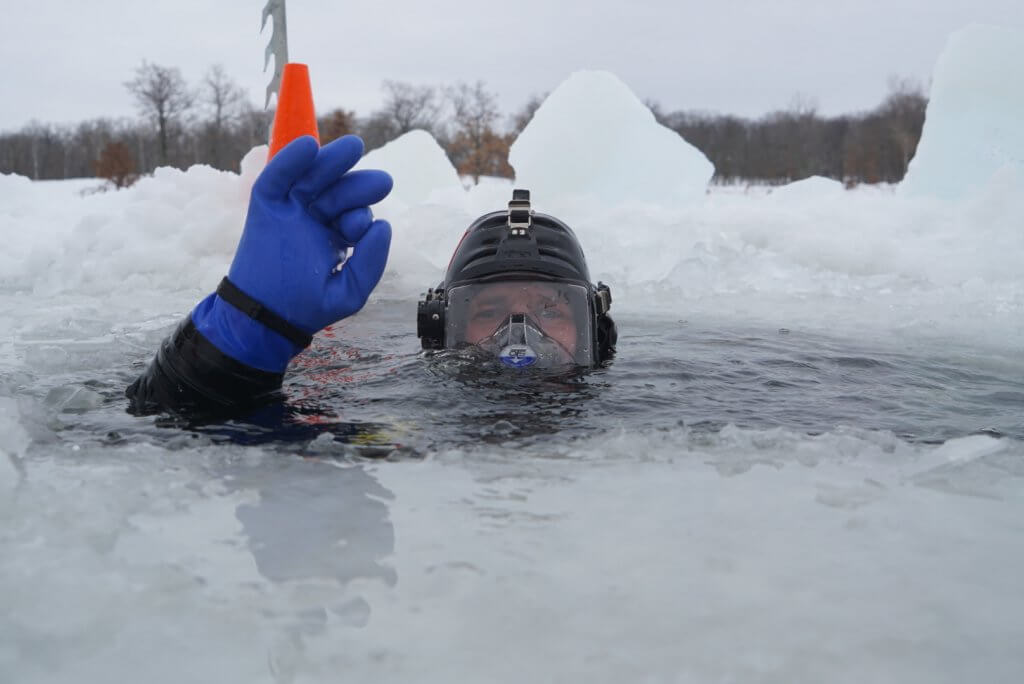More than a dozen divers converged at Camp Ripley, Minnesota, last month to learn how to complete missions while combating frigid temperatures.
This year marked the first time the 53,000-acre regional training center hosted the U.S. Coast Guard’s Cold Water Ice Diver course. DV1 Josh Bredesen, a dive instructor for the course, said previous training sessions were held in Seattle for one week, followed by a second week in Canada. With the new location, all training is centralized to one site.
“They have been absolutely amazing,” Breseden said of Camp Ripley. “They have opened up their doors… We have more amenities here than we did in Canada.”
Brig Gen. Lowell Kruse, Minnesota National Guard’s assistant adjutant general and Camp Ripley’s senior commander, said in a statement to Reserve & National Guard Magazine that the training center’s ability to host the dive course is in line with the DOD “arctic strategy.”
“To be able to host the USCG extreme cold weather dive team is just another example of how Camp Ripley is uniquely tailored to the DOD’s Arctic Strategy and is ready to host any and all branches looking to train yearround,” he said in a statement provided to Reserve & National Guard Magazine, “and specifically in extreme cold weather environments, our location makes it possible to train in a cold harsh environment and we are prepared to provide them with not only superior customer service but with all of their logistical needs.
“We are excited to have them establish a permanent part of their Dive training here at Camp Ripley, which enabled them to not only save a lot time but a significant savings in cost compared to training elsewhere and we will continue to work with each other to grow our partnership.”
Relocating dive training to Minnesota, according to Breseden, also allows students to dive safer, more efficiently and provide housing for students.
‘Crawl-walk-run’
The two-week training takes a “crawl-walk-run” format, Bredesen said, with participants starting out practicing emergency procedures in dive tanks.
“It’s super controlled, like 42-degree water,” Bredesen said. “It’s inside. It’s temperature-controlled for us that are topside. They’re practicing what they would do in the event that they would have an emergency under the ice.”
In the “walk” phase, trainees have a “familiarization dive” under ice Ferrell Lake – a shallow lake on Camp Ripley.
“They get to see what it is like setting up our entire dive site and diving without the depth,” Breseden said. “So it’s very shallow. [They get to] see what it’s like to be under the ice.”
After a couple of days acclimating to the environment, the dive site then moves to Lake Alott – a more remote body of water on Camp Ripley.
“Here we are diving in about 35 feet of water, and this is where the students are practicing different tasks, such as searching and looking for the emergency hole,” Bredesen said.
This situation gives divers the opportunity to practice “lost diver procedures” and to learn what it’s like working with the dive suit.
Each participant does about four dives, according to Bredesen.
Dive training benefits
One of the biggest benefits as Coast Guard divers, Bredesen said, is that the training allows students to feel what it’s like to be in a suit when temperatures plunge below zero and the water ranges from 32 degrees to 35 degrees.
“It’s not something that everyone gets to do often… [The training] prepares them for any type of job that can come up in the fleet,” he said.
RELATED: 124th Medical Group trains with Idaho Army aviators on MEDEVAC
Diver Kirsten Allen, who was in the Coast Guard Reserve for six years before transitioning to active duty, said the sub-zero temperatures during the course offered the opportunity for divers to “actually experience those hiccups” and know they can still operate. The experience, she said, was “eye opening.”
“I think my biggest takeaway was being able to successfully operate in those kinds of conditions because it is very hostile,” Allen said. “Even just for regular people, if you’re diving, that adds a whole nother level to it… The smallest little mistake can really snowball and cause some catastrophic stuff to happen… [but] it can be done, and it can be done successfully.”
Most students in the training, like Allen, are qualified Coast Guard divers with six months to one year of experience, though Army and Navy divers who participate have more experience, according to Bredesen.
Some days divers are under the ice when the temperature is 40 degrees, while the week prior, it was -43 degrees with the windchill.
“Seeing the way students are able to persevere through extreme temperatures and being under the ice, [doing] something never done before… From day 1 to day 12… seems like night and day,” he said.
The early February training included 12 Coast Guard students, two Army and two Navy.
The annual training is organized and run by Coast Guard instructors.

